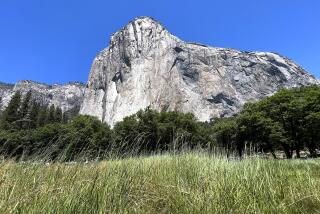National Parks a Bargain Even With the Higher Fees
- Share via
Tens of millions of visitors flock to U.S. national parks each year to commune with nature and witness spectacular treasures of our wilderness. But it will soon cost visitors a little more to stand at the rim of the Grand Canyon, await the eruption of Old Faithful geyser at Yellowstone and gaze in awe at Half Dome in Yosemite. Even at the extra cost, however, national parks are still a vacation bargain for most travelers. A three-year trial program of higher visitor fees will be the test.
Visitor fees at more than 100 popular national parks and other recreation areas will rise next year to help pay for repairs and improvements under a program announced by Interior Secretary Bruce Babbitt.
At the four most visited national parks--Yosemite, Yellowstone, Grand Canyon and Grand Teton--the fee will be $20 per vehicle for seven days. The current fee at Yosemite is $5 per car. The other three now collect $10 per car. At the California national parks other than Yosemite--Sequoia, Kings Canyon and Death Valley--fees will rise to $10 from $5.
Ideally, national parks should be free, but fees have been imposed since 1915 when the secretary of the Interior decreed that automobiles be allowed on park roads for $5 per five-person vehicle. If present-day visitors had to pay the 1915 fee in 1996 dollars, it would be $78.13.
Annual funding for parks, adjusted for inflation, declined by $202 million from 1983 to 1996. That has resulted in reductions in park maintenance and personnel at the very time extra attention is needed because of the huge number of visitors--270 million last year.
The parks now have a $4-billion maintenance backlog that ranges from smoothing axle-busting roads in the Grand Teton National Park to repairing a leaky roof at the Grand Canyon headquarters.
The new charge of $20 per car for a seven-day visit is a recreational value especially considering it can cost as much as $7 for one person to see a movie at a theater and soon will cost $21 for the cheapest ticket at a Laker game. The fee for a vehicle would not buy even one entry to Disneyland.
Congress authorized the trial fee program outlined this week by Babbitt. The parks will keep 80% of the money they collect. The remaining funds will go to other parks, recreation areas and wildlife refuges where fees will not be raised. Until now, most visitor fees collected went into the federal treasury. Babbitt said the new fees will raise $30 million to $50 million for needed enhancements. Visitors facing the higher charges will find comfort in the knowledge that the money will go directly to the parks.
More to Read
Sign up for The Wild
We’ll help you find the best places to hike, bike and run, as well as the perfect silent spots for meditation and yoga.
You may occasionally receive promotional content from the Los Angeles Times.






